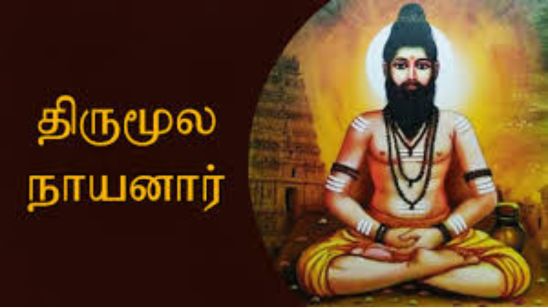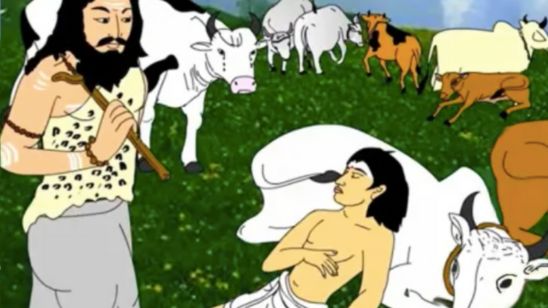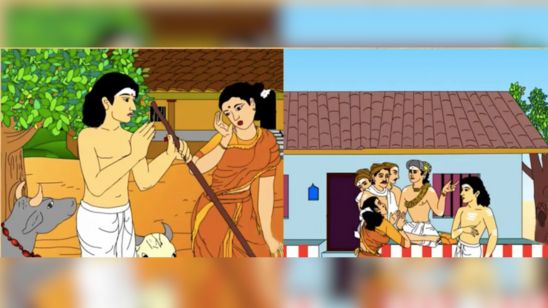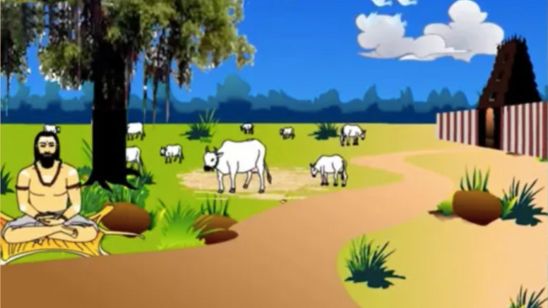
Siddhars are enlightened sages and saints with supernatural abilities who go beyond time. They can live up to thousands of years and teleport themselves to any part of creation. They are deathless and have the power to decide when and where to shed their bodies. Through intense yogic and meditative practises, a person can attain enlightenment. When a Saint attains the Siddhis (magic powers), they are Siddhars. According to Indian Texts, there are 8 Siddhis.
There are 63 Nayanmars. Nayanmars are Saints who lived during the 6th - 8th century and devoted their lives to Lord Shiva. They were instrumental in spreading the messages and teachings of Lord Shiva and travelled widely. Siddhar Thirumoolar is one of the Nayanmars. Siddhar Thirumoolar is also one among the ' Pathinen Siddhargal ' (The 18 great Siddhars celebrated in South India). He is one of the siddhars who gave us the Siddha system of medicine for healing the body. He is acclaimed for looking at Siddha as an art. Siddhar Thirumoolar originated from the Kailash range of the Himalayas but later settled in Tamil Nadu, earning the love and respect of the people of Tamil Nadu.

The life of Siddhar Thirumoolar
In the Kailash range of the Himalayas, a great disciple of Lord Shiva called Sundaranaathar was present. He studied under the tutelage of the great Shri Nandhi Deva. He became the exponent of the Vedas and attained many Siddhis. One day, Sundaranaathar yearned to meet the great sage Agasthiar. Sundaranaadhar knew that sage Agasthiar was in the Podigai hills (part of the western ghats / Sahyadri) in the Thirunelveli district of Tamil Nadu. After getting a blessing from his guru, Sundaranaathar left Kailash and began his journey to South India. En route his journey, he prayed at many Shiva temples. He prayed at Lord Pashupathi temple, Kedarnath temple, Thiru Kalahasthi temple, Thiru Ekambaranathar temple and Thiru Thillai Natarajar temple. He even took a holy dip in River Kauvery.
One day, he was strolling on the bank of river Kauvery. He heard the distressed mooing of cows nearby. He was a soft-hearted saint and immediately went towards the cows who were in distress. Sundaranaathar was saddened to see the cowherd - Moolan ( belonging to the village Sathanoor) dead. The cows had circled their beloved master and were desperately licking and mooing at the dead body to wake him up. Touched by this act, Sundaranaathar knew that Moolan was a kind and gentle person, and the cows adored him.
Out of pity for the cows, Sundaranaathar exchanged his soul with the body of Moolan. Sundaranaathar was well versed in the Siddhi - exchanging souls between two bodies. Now, the soul of Sundaranaathar was inside the body of Moolan. Moolan woke up. From this day onwards, Sundaranaathar was called Thiru Moolar. Sundaranaathar left his body near the banks of River Kauvery. The cows rejoiced to see their beloved master once again. Thirumoolar was also happy to see the cows in a jubilant mood. Time passed by, and soon it was evening. The cows turned to go back home.
Thirumoolar cared for the safety of the cows. Hence, he followed the herd back into the village. From divine intuition, Thirumoolar knew that Moolan was married, and his wife was waiting at home. The saint was in a fix now. After the cows went home, Thirumoolar was engrossed in deep thought of how to explain the passing away of her husband (when the saint was inside Moolan’s body).
Meanwhile, Moolan’s wife was anxious that her husband did not return home from work. She started searching for her husband everywhere. She found Thirumoolar in deep meditation under a tree and demanded that he come home. Thirumoolar kept quiet. He did not know how to break the sad news to her. Seeing the silence, the wife was aghast. She started pulling him. Since the saint was a strict follower of Shaivite traditions, he retracted his hand. He then advised the wife to forget about Moolan and find peace at the feet of Lord Shiva. Hearing this, the wife was shocked and went home crying.

The following day, the wife was disturbed that her husband did not come home for the night. She was desperate to get her husband back. She approached the village elders and narrated all that transpired the day before and how her husband had lost his mind. The village elders gathered in front of Thirumoolar, who was in deep meditation. The sheer presence of the saint and the glow of his face made the elders realise that it was not Moolan. The elders bowed and touched the feet of the saint and went home. The wife slowly realised that her husband would never come back. She slowly bowed down and went home.
Thirumoolar came out of his meditation and decided to switch his soul into his original body. But alas! He could not find his body near the river bank. He went into deep meditation and realised that Lord Shiva wished for him to stay in Tamil Nadu and to write and spread his messages in the south. He also realised that it was Shiva who made his body disappear.
Thirumoolar’s Thirumandiram
Thirumoolar reached the Thiruvaavadurai temple dedicated to Lord Shiva. After praying to the Lord, Thirumoolar sat under an Arasa Maram ( Peepal Tree) present just outside the temple premises and went into deep meditation. Every year, Thirumoolar emerged from his deep meditativeness, wrote a song/hymn (on palm leaves) and went back into meditation. He repeated this for all his 3000 verses ( hence, it took 3000 years for him to complete his literary work). His songs contained information on Lord Shiva, meditation and deep knowledge about attaining the divine. His literary work is known as Thirumandiram, meaning Respectful Mantras.
Thirumandiram is truly an elixir of the divine knowledge. After completing his work, Thirumoolar felt that the compilations and content of his work were very high for the people to comprehend. He buried the palm leaves under the earth near the Kodi Maram ( Flag post) of the Thiruvaavadurai temple before heading to Chidambaram. After about 4000 years, a great Shaiva Nayanmar, Thirugnaanasambanthar, arrived at the Thiruvaavadurai temple. Through his divine intuition, he unearthed the Thirumandiram.

Literature mentioning Thirumoolar
Sekkizhar was a saint and an ardent devotee of Lord Shiva. He compiled and wrote the Periya puranam that recounts the life and works of the 63 Shiva Nayanmars. Periya puranam is very sacred. It is considered a Tamil masterpiece. Though Saint Thirumoolar is a Siddhar, he finds mention in Periyapuranam as a Shaiva Saint of the Siddhanta tradition.
Nambiyandar Nambi is a great Shiva devotee. He combined the songs written by the 63 Nayanmars into 12 books. His compilation is called the Thirumurai. He included the Thirumandiram as the 10th book.
The life of Thirumoolar may seem to be a superficial fairytale or a bedtime story to be passed on to younger generations but, there is a deeper meaning and learning for a true devotee. The Life of Thirumoolar teaches us that one should be ready to let go of all the possessions and attachments in this world to realise the divine. One should not have to think twice (to shed one’s name, fame, wealth or even body) because things like body, one’s thoughts or even one’s name are all but one big fallacy.
 Vaishnavi Gurusankar is a passionate educator, a wife and a mother. She has over a decade of experience as an educator and has been closely working with teachers and children of all ages. She is also an active parenting blogger and founder of Magical Unicorn, an exclusive parenting blog founded on Indian ethos, values and stories at its core. She has also authored the book "Bharatyam : Science behind Hindu Practices & Way of Life"
Vaishnavi Gurusankar is a passionate educator, a wife and a mother. She has over a decade of experience as an educator and has been closely working with teachers and children of all ages. She is also an active parenting blogger and founder of Magical Unicorn, an exclusive parenting blog founded on Indian ethos, values and stories at its core. She has also authored the book "Bharatyam : Science behind Hindu Practices & Way of Life"
NEXT ARTICLE

At the southernmost tip of this mesmerising ensemble lies the majestic Great Nicobar Island, boasting an impressive landmass of about 910 square kilom...

Bharath has always been a land traversed by spiritual masters/ Guru since time immemorial. These spiritual masters have always upheld the core princip...

South India contains its fair share of unique pilgrimage centres. These divine places of worship have a prominent Sthala Purana, devoted followers, di...